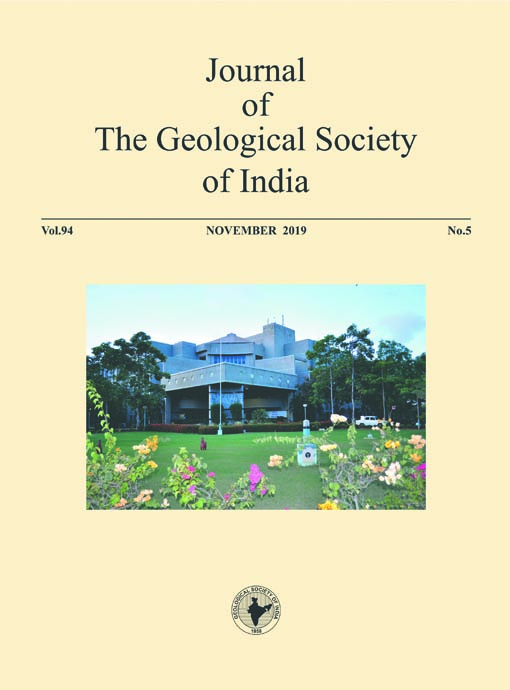Appraising Hydro-Dynamics of Alluvial Aquifers from Indo-Gangetic Plains
DOI:
https://doi.org/10.1007/s12594-019-1342-2Keywords:
No Keywords.Abstract
Aquifer behaviour in alluvial plains is a complex phenomenon owing to the discrete lithological units, hydro-dynamics and erratic rainfall patterns. Therefore, the aquifer geometry, recharge and rainfall which define the hydro-dynamics of alluvial aquifers are important to understand in view of sustainable groundwater management. This study appraises the time series hydro-climatic data on daily basis during July-2008 to March-2011 in Indo-Gangetic plains, India. It includes field site monitoring of six piezometric wells installed with borehole data loggers and daily rainfall events. The temporal variations recorded for hydro-climatic (i.e. piezometric surface and rainfall) data sets are examined applying classical statistical tools. Results showed, a) the linear regression value R2 = 0.81-0.98 (mean: 0.94) calculated for consecutive three monsoons indicated the rise of static WL by 1.59 m/monsoon, b) the linear trend for three hydrological cycles denotes, rainfall deficit of 9.83% and 14.10% corresponds to WL decline by 0.914 m and 1.478 m, c) for an individual hydrological year, a negative response of rainfall to WL decline with correlation coefficient r = -0.921 indicates multiple variables of aquifer discharge. The derived negative linearity y = -1.196x + 223.35 has assisted to simulate the declining mode of WL by 1.196 m/year. It assists to draw the similar results for alluvial aquifers in other regions of Indo-Gangetic plains.Downloads
Metrics
Issue
Section
Downloads
Published
How to Cite
References
Amarasinghe, U.A., Shah, T., Turral, H., Anand, B.K. (2007) India's water future to 2025-2050: Business-as-usual scenario and deviations, IWMI Res. Rep. 123, 47p., Internat. Water Managmt. Inst., Colombo, Sri Lanka.
Brown, R.H., Konoplyantslev, A.A., Ineson, J., Kovalevsky, V.S. (1972) Ground-water studies - an international guide for research and practice. UNESCO Publications, pp.8.1
CGWB (2011) Dynamic Ground Water Resources of India (As on 31st March 2009). Ministry of Water Resources, Government of India, Faridabad (Available at http://cgwb.gov.in/)
CGWB (2012) Ground Water Year Book - India. Central Ground Water Board, Ministry of Water Resources, Government of India Faridabad, pp. 14. (http://cgwb.gov.in)
CGWB (2014) Ground Water Year Book 2013-2014. Central Ground Water Board, Ministry of Water Resources, Government of India Faridabad, pp. 2. (http://cgwb.gov.in)
Chawla, J.K., Kheparb, S.D., Sondhic, S.K,, Yadavd, A.K. (2010) Assessment of long-term groundwater behaviour in Punjab, India. Water International, v.35(1), pp.63-77
Chen, H.U., Guoa, S., Chong-yu xu., Singh, V.P. (2007) Historical temporal trends of hydro-climatic variables and runoff response to climate variability and their relevance in water resource management in the Hanjiang basin. Jour. Hydrol., v.344, pp.171–184
Crosbie, R., Binning, P., Kalma, J. (2005) A time series approach to inferring groundwater recharge using the water table fluctuation method. Water Resources Res., v.41(1), pp.1-9.
Das, S. (2012) Book review-The atlas of water, by Maggie Black and Jannet King. Earthscan, 2009, 2nd Edition New Delhi. Jour. Geol. Soc. India, v.80(2), pp.287-289
Hesel, D.R., Hirsch, R.M. (1992) Statistical Methods in Water Resources, Elsevier, Amsterdam.
Kampata, J.M., Parida, B.P., Moalafhi, D.B. (2008) Trend analysis of rainfall in the head streams of the Zambezi River Basin in Zambia. Physics and Chemistry of the Earth, v.33, pp.621-625.
Karanth, K.R. (1987) Ground water assessment: development and management. Tata McGraw-Hill, New Delhi, pp.720
Kaur, S., Aggarwal, R., Soni, A. (2011) Study of water-table behaviour for the Indian Punjab using GIS. Water Sci. Tech., v.63(8), pp.1574-81.
Kendall, M.G. (1955) Rank Correlation Methods, Charles Griffin: London.
Kumar, V., Jain, S.K., Singh, Y. (2010) Analysis of long-term rainfall trends in India. Hydrological Sci. Jour., v.55(4), pp.484-496.
Mondal, A., Kundu, S., Mukhopadhyay, A. (2012) Rainfall trend analysis by Mann-Kendall Test: A case study of North- Eastern part of Cuttack district, Orissa. Internat. Jour. Geol., Earth Environ. Sci. v.2(1), pp.70-78.
Patle, G.T., Singh, D.K., Sarangi, A., Rai, A., Khanna, M., Sahoo, R.N. (2015) Time Series Analysis of Groundwater Levels and Projection of Future Trend. Jour. Geol. Soc. India, v.85(2), pp.232-242.
Rosegrant, M.W., Cai, X., Cline, S.A. (2002) World water and food 2025. Dealing with scarcity. Washington, D.C., USA. International Food Policy Research Institute.
Tiwari, V.M., Wahr, J., Swenson, S. (2009) Dwindling groundwater resources in northern India, from satellite gravity observations. Geophys. Res. Lett., v.36(18), pp.401, doi:10.1029/2009GL039401

 Sahebrao Sonkamble
Sahebrao Sonkamble






